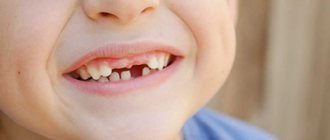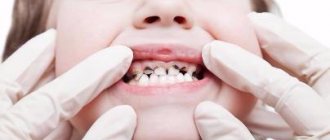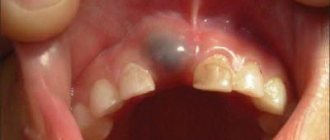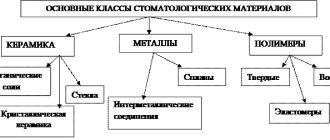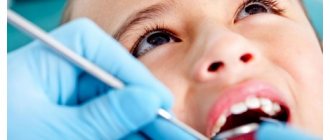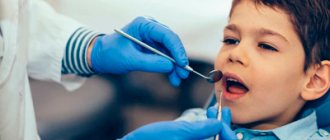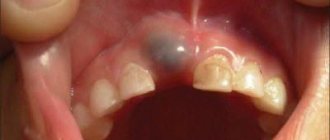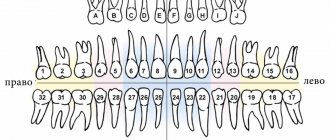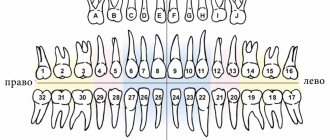What are baby teeth?
A child may believe that baby teeth are needed only so that the Tooth Fairy has something to build her snow-white castle from. But adults should know the truth. When a child is still very small, his head, and therefore his jaw, are small. If the baby, instead of milk teeth, began to cut molars immediately, they would not fit into the mouth either in size or in number. Therefore, nature gave us a temporary solution for the first ten years.
There are 20 primary teeth in total (10 each on the upper and lower jaws). These are incisors - central and lateral, canines, and molars. Usually, a child already has all of them at the age of 3-3.5 years.
Milk teeth differ from primary teeth not only in size, but also in structure. The enamel of primary teeth is approximately 2 times thinner and not as rich in minerals. Therefore, the child needs to carefully monitor oral hygiene - caries on baby teeth develops very quickly. Milk teeth have thin not only enamel, but also the layer underneath it - dentin - so caries quickly develops into pulpitis. Baby teeth have both nerves and roots, but they are shorter than molars. The latter gradually “dissolve” during the period of change of bite. This is why the teeth begin to loosen.
If baby teeth are not taken care of and treated, the child’s gums may become inflamed, and the embryos of the molars may suffer or die. Don't leave caries unattended!
Can teeth grow a third time?
It turns out that there are many such cases, however, on the scale of our planet, this is a drop in the ocean. Unfortunately, the mechanism of such tooth regeneration is still unknown, although, according to the sages, people of previous civilizations, say, the Hyperboreans and Atlanteans, did not suffer from lack of teeth in old age, which is typical for modern people. However, they also knew how to levitate, teleport, read minds, move and lift objects with their thoughts (for example, the Mayan tribes did not know wheels, but they moved any loads and multi-ton stone slabs with fantastic ease that we can only dream of) and much more. But even today there are people capable of all this. There are also those lucky ones who experienced the third change of teeth...
How and when do teeth change?
Loss of primary teeth begins at approximately 6-7 years of age and usually lasts until 10-12 years of age. Note that girls say goodbye to temporary teeth earlier than boys and the replacement process itself is more dynamic for them.
Parents will be able to guess that their child’s baby teeth are about to change due to a number of factors: due to jaw growth, the distance between the incisors will increase, the rudiments of molars become visible under the baby teeth, and the primary teeth become loose.
On average, the age at which a child changes teeth corresponds to the years given in the tables below:
Order of loss of baby teeth
| Age | What teeth fall out |
| 6-7 years | Central incisors fall out |
| 7-8 years | Lateral incisors fall out |
| 9-11 years | The child loses his first molars |
| 10-12 | Canines and second molars fall out |
⠀
Please note that the new tooth may not be in a hurry to take the place of the fallen one. If a couple of weeks or even more than a month have passed and there is still no molar, this is not a reason to panic. Also keep in mind that there are more molars, so some take their place without changing their predecessors. For example, molars or (the first permanent molars), erupt from scratch at the age of 5-7 years - they should not be confused with milk teeth.
Growth of molars
Molars are called a little differently than baby teeth. Try not to get confused:
| Molar | Age of appearance | Which milk tooth replaces |
| Central incisors | 6-8 years | Central incisors |
| Lateral incisors | 7-9 years | Lateral incisors |
| Fangs | 10-13 years | Fangs |
| First premolars | 9-12 years | First molar |
| Second premolars | 10-13 years | Second molar |
| First molars | 5-7 years | Do not replace baby teeth |
| Second molars | 11-14 years old | Do not replace baby teeth |
| Third molars | 17-25 years old | Do not replace baby teeth |
⠀
If you do not take into account the third molars (which are also called wisdom teeth), girls receive a fully formed jaw by 11-13 years, and boys by 13-14 years.
It is important to understand that the baby tooth may not be replaced. For example, if the germ of a molar tooth has died, then nothing pushes the temporary tooth to leave the mouth. People live with partial milk teeth even into their 30s. Therefore, if a baby tooth does not fall out, you should not try to loosen it or try to pull it out at home. Below we will look at other problems when changing teeth.
Deviations in timing and problems when changing teeth
One or another problem with the loss of baby teeth and the germination of molars occurs in at least every tenth child. Fortunately, dentists are ready to correct the bite during the growth stage, remove extra teeth, and even insert an implant if there is no point in waiting for a root one.
Let's look at the main deviations that may cause concern:
"Shark's Mouth"
Sometimes baby teeth do not have time to fall out, but the molars have already grown “second row”. The “shark’s mouth” is not worth admiring. You need to go to the dentist as soon as possible and remove unnecessary temporary teeth, otherwise your bite may be significantly damaged.
Untimely change of teeth
If the first baby teeth begin to leave the baby’s mouth before 5 years of age or after 8 years of age, then this is a deviation from the norm, which means you need to understand the reason. Trauma, caries, ecology, nutrition, congenital problems with bite or other heredity, various infectious diseases, hormonal problems (for example, thyroid disease), as well as diseases due to which the child is at risk for underdevelopment and delay may be to blame. formation of permanent dentition (diabetes, leukemia, immunodeficiency and others).
The molar does not grow in place of the lost milk tooth
There is no need to panic, but it is worth consulting with a specialist. For example, if a molar tooth does not erupt, although the baby tooth has fallen out a long time ago, the reason cannot be determined with ordinary eyes, but an x-ray will help. If there is no tooth germ in the picture, this is called adentia. This problem is extremely rare - the tooth simply has nothing to grow from. The decision will require the help of a prosthetist.
With retention, the germ of a new tooth is present, but it is directed incorrectly or is deep in the gum. All that remains is to wait for the tooth to grow. This problem occurs more often in the lower third molars, as well as in the upper incisors and canines.
With impaction, the tooth cannot come out due to the close fit of neighboring teeth. Here, too, you cannot do without the help of professionals.
We also advise you to consult a doctor if:
- molars appear darkened or grow crooked;
- the order of tooth loss and growth differs significantly from the above graphs;
- the child’s gums hurt and his cheek is swollen;
- baby tooth is corroded by caries;
- a tooth fell out, but blood from the socket does not stop oozing for more than an hour (not to be confused with ichor).
Alternatives to Growing Teeth
Today, the problem of missing teeth is relatively easy to solve. Dentists offer not only the elimination of an aesthetic defect, but also the restoration of the functionality of the dentition. If the tooth could not be saved, then the situation can be corrected with the help of prosthetics or implantation. Each of these methods has both advantages and disadvantages. Let's take a closer look at them.
Dental implantation: advantages and disadvantages
Advantages of implantation compared to prosthetics:
- Correction of various dental defects - from one tooth to a row of teeth.
- Possibility of using different dentures in the absence of teeth.
- It is possible to prevent bone resorption.
- You can eat any food.
- Manages to keep gums healthy.
Disadvantages of implantation:
- High price.
- A relatively large number of contraindications.
- Possibility of poor implant survival.
- Long (up to 6 months) period of engraftment and adaptation to the implant.
Dental prosthetics: advantages and disadvantages
Advantages of prosthetics compared to implantation:
- The procedure is noticeably cheaper than implantation.
- Relatively short recovery time for a tooth or dentition.
- Quite a wide selection of prosthetic structures.
- A small number of contraindications.
- Relatively quick adaptation to the prosthesis (up to 2 months).
Disadvantages of prosthetics without implantation:
- Discomfort in the oral cavity up to the appearance of a gag reflex.
- The need to grind adjacent teeth.
- Relatively less wear resistance.
- Risk of an allergic reaction to prosthetic materials.
Taking into account the advantages and disadvantages of implantation and prosthetics, the doctor selects the best option for the patient. Both medical indications and the wishes of the patient are taken into account.
Is it possible to pull out a baby tooth yourself?
At home, you can remove a baby tooth only if it is well loosened and you can walk freely in the socket.
It is important that the child does not have a cold: coughing, sneezing, runny nose - these are stop signals for home removal of a baby tooth. Examine the child’s mouth - if there is swelling or bleeding of the gums, your manipulations may lead to infection in the socket. It's better to see a dentist.
If you still decide to pull out a baby tooth, it is better not to experiment with tying the object to be removed to the door handle.
The best way is this: wrap the tooth with gauze soaked in alcohol and pull it out of the hole until it comes out. The tooth can also be wrapped with sterile thread and pulled strictly perpendicular to the jaw.
After the manipulations are successful, the child needs to rinse his mouth, the parent needs to see if there are any parts of the tooth left in the socket (if the tooth is broken and something remains, you need to go to the doctor). Sterile cotton wool is placed in the hole for 20 minutes: the child must press it with his teeth to stop the bleeding. Make sure your child does not drink or eat for a couple of hours after tooth extraction.
If the tooth falls out on its own, also put cotton wool in the hole and do not let the baby drink or eat for a while.
What not to do?
The following rules will help you avoid bite problems and the appearance of various defects:
- do not allow your child to loosen his teeth if they are not yet going to fall out and are firmly in place;
- teach your child not to touch a loose tooth with dirty hands (and, of course, he should not pick the hole when the tooth has just fallen out);
- Do not give your child a lot of solid foods during the period of bite changes. This way he can break a baby tooth;
- do not fill the hole after tooth loss with alcohol;
- You shouldn’t make fun of your child’s temporary toothlessness.
Where to put baby teeth after they fall out?
The first tooth can be kept as a souvenir or given to the child to put in a box with children's valuables. If sentimentality is not accepted in your family, then the tooth can be thrown out.
In many families, the tooth is placed under the pillow to be taken away in exchange for a coin or small treat by the Tooth Fairy. This character came to us from the West. The fairy builds a castle from children's teeth in which good dreams are born.
But there is also a domestic tradition - to give a lost tooth to a mouse, which can also thank you with a gift. Previously, the tooth was thrown underground or hidden behind the stove with the words “Here, mouse, a bast tooth! Give me a bone one, mouse!” Now this story is more suitable for residents of private houses. It's up to you to decide whether it's worth chasing a mouse into an apartment on the 20th floor, even if it's a fabulous one. But you can take absolutely any magical character that your child likes and come up with a story about where and why the baby’s tooth will end up.
Interesting fact: baby teeth contain both stem and progenitor cells. Scientists believe that in the future, with the development of science and technology, baby teeth can be used for the benefit of their owners, for example, to treat serious diseases. But in order to preserve the cells in the tooth, special storage conditions are required, which, unfortunately, cannot be created at home.
Growing teeth - myth or reality
Once upon a time, a person was a single cell, from which the germ layers were subsequently formed, and from them - separate organ systems.
Even at the beginning of the last century, biologists understood that the process of growing new tissue or organ was theoretically possible. In practice, this was difficult to implement due to the lack of necessary conditions and a deep understanding of the relevant processes. Today, tissue growing is a reality. In laboratories, for example, you can grow skin. By the way, this technology is already used for burn patients. As for growing organs, there are successes here too, although not yet of a medical nature. A simplified model of this process is as follows: using a bioprinter, cells that form organ tissue are applied to the frame. In this case, instead of ink, the bioprinter contains stem cells, which, after being applied to the frame, are specialized into the appropriate cells (for example, cells of the heart, kidneys, liver, and so on).
If you think that growing teeth is easier than growing other organs, you are mistaken. Teeth grow from many different types of cells. In particular, ameloblasts form enamel; odontoblasts – dentin; cementoblasts - cement. In addition, formed teeth also contain immune system cells and receptors that detect changes in pressure and temperature.
One of the problems that scientists face when trying to grow teeth is the origin of tooth precursor cells. Thus, ameloblasts come from the ectoderm (the outer layer of the embryo), odontoblasts and cementoblasts come from the neural crest (the fourth germ layer). In other words, researchers are faced with the task of mixing different types of cells in certain proportions. In addition, these cells need to be given the conditions so that they can specialize into tooth precursor cells. For this reason, no one has yet been able to grow a tooth outside the body. Scientists are still working on how to force the jaw to grow new teeth when for natural reasons this is no longer possible. This approach seems feasible at this stage of scientific development. Completely growing a tooth “in vitro” is a matter of several decades, unless epochal changes in technology occur in the foreseeable future.
